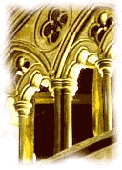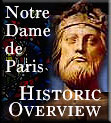

'Must Know' Structural Features of a
Gothic Cathedral:

 The Lady Chapel will be found in all the Notre Dames, as well as many of the Great Gothic Cathedrals. Usually located behind the Sanctuary, these spaces are dedicated to - sometimes set aside for the use of - the Blessed Virgin.
The Lady Chapel will be found in all the Notre Dames, as well as many of the Great Gothic Cathedrals. Usually located behind the Sanctuary, these spaces are dedicated to - sometimes set aside for the use of - the Blessed Virgin. While glass windows were used in cathedrals of other countries, the Rose Window was initially a French creation, first appearing at St-Denis.
While glass windows were used in cathedrals of other countries, the Rose Window was initially a French creation, first appearing at St-Denis.“Great edifices, like the great mountains, are the work of ages. Often art undergoes a transformation while they are waiting  pending completion—pendent opera interrupta—they then proceed imperturbably in conformity with the new order of things. The new art takes possession of the monument at the point at which it finds it, absorbs itself into it, develops it after its own idea, and completes it if it can. The matter is accomplished without disturbance, without effort, without reaction, in obedience to an undeviating, peaceful law of nature—a shoot is grafted on, the sap circulates, a fresh vegetation is in progress. Truly, there is matter for mighty volumes; often, indeed, for a universal history of mankind, in these successive layers of different periods of art, on different levels of the same edifice. The man, the artist, the individual, are lost sight of in these massive piles that have no record of authorship; they are an epitome, a totalization of human intelligence. Time is the architect—a nation is the builder.”
pending completion—pendent opera interrupta—they then proceed imperturbably in conformity with the new order of things. The new art takes possession of the monument at the point at which it finds it, absorbs itself into it, develops it after its own idea, and completes it if it can. The matter is accomplished without disturbance, without effort, without reaction, in obedience to an undeviating, peaceful law of nature—a shoot is grafted on, the sap circulates, a fresh vegetation is in progress. Truly, there is matter for mighty volumes; often, indeed, for a universal history of mankind, in these successive layers of different periods of art, on different levels of the same edifice. The man, the artist, the individual, are lost sight of in these massive piles that have no record of authorship; they are an epitome, a totalization of human intelligence. Time is the architect—a nation is the builder.”
“The word Architecture has, I suppose, to most of you the meaning of the art of building nobly and ornamentally. Now I believe the practice of this art to be one of the most important things which man can turn his hand to, and the consideration of it to be worth the attention of serious people, not for an hour only, but for a good part of their lives, even though they may not have to do with it professionally.
But, noble as that art is by itself, and though it is specially the art of civilisation, it neither ever has existed nor never can exist alive and progressive by itself, but must cherish and be cherished by all the crafts whereby men make the things which they intend shall be beautiful, and shall last somewhat beyond the passing day.
A great subject truly, for it embraces the consideration of the whole external surroundings of the life of man; we cannot escape from it if we would so long as we are part of civilisation, for it means the moulding and altering to human needs of the very face of the earth itself, except in the outermost desert.
Neither can we hand over our interests in it to a little band of learned men, and bid them seek and discover, and fashion, that we may at last stand by and wonder at the work, and learn a little of how 'twas all done: 'tis we ourselves, each one of us, who must keep watch and ward over the fairness of the earth, and each with his own soul and hand do his due share therein, lest we deliver to our sons a lesser treasure than our fathers left to us.”
—William Morris, Hopes and Fears for ArtBibliography
Matthew Holbeche Bloxam, London, D. Bogue (1846)
Eugène Viollet-le-Duc, Paris (1858-68)
Development & Production Credits
Primary Text : Rhey Cedron — Theme Editor : Nicole MarchStructural Design & Project Direction : Rhey Cedron
Art Direction : Rhey Cedron — Art Production : Mark Nelson & Ash' Murti
Artistic Consultant : Thierry Alberto
Art Research : Malcolm Hurrell — Support Research : Walter McCrae
(Life) Support Production : Henry Craig, Joan Flandrin, Clara Kelly and
a Patient Legion of Friends, Family & Angels
cultural projects. Ask to receive your free newsletter
Your questions or comments are always welcome!
Gothic Dreams E-mail
Individual use of enclosed material is encouraged for the purposes of education and enjoyment.
The republication of textual or graphic content, without license, is an infringement of Copyright laws.

